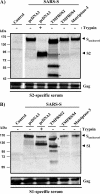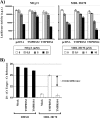Evidence that TMPRSS2 activates the severe acute respiratory syndrome coronavirus spike protein for membrane fusion and reduces viral control by the humoral immune response
- PMID: 21325420
- PMCID: PMC3126222
- DOI: 10.1128/JVI.02232-10
Evidence that TMPRSS2 activates the severe acute respiratory syndrome coronavirus spike protein for membrane fusion and reduces viral control by the humoral immune response
Abstract
The spike (S) protein of the severe acute respiratory syndrome coronavirus (SARS-CoV) can be proteolytically activated by cathepsins B and L upon viral uptake into target cell endosomes. In contrast, it is largely unknown whether host cell proteases located in the secretory pathway of infected cells and/or on the surface of target cells can cleave SARS S. We along with others could previously show that the type II transmembrane protease TMPRSS2 activates the influenza virus hemagglutinin and the human metapneumovirus F protein by cleavage. Here, we assessed whether SARS S is proteolytically processed by TMPRSS2. Western blot analysis revealed that SARS S was cleaved into several fragments upon coexpression of TMPRSS2 (cis-cleavage) and upon contact between SARS S-expressing cells and TMPRSS2-positive cells (trans-cleavage). cis-cleavage resulted in release of SARS S fragments into the cellular supernatant and in inhibition of antibody-mediated neutralization, most likely because SARS S fragments function as antibody decoys. trans-cleavage activated SARS S on effector cells for fusion with target cells and allowed efficient SARS S-driven viral entry into targets treated with a lysosomotropic agent or a cathepsin inhibitor. Finally, ACE2, the cellular receptor for SARS-CoV, and TMPRSS2 were found to be coexpressed by type II pneumocytes, which represent important viral target cells, suggesting that SARS S is cleaved by TMPRSS2 in the lung of SARS-CoV-infected individuals. In summary, we show that TMPRSS2 might promote viral spread and pathogenesis by diminishing viral recognition by neutralizing antibodies and by activating SARS S for cell-cell and virus-cell fusion.
Figures







Similar articles
-
Cleavage and activation of the severe acute respiratory syndrome coronavirus spike protein by human airway trypsin-like protease.J Virol. 2011 Dec;85(24):13363-72. doi: 10.1128/JVI.05300-11. Epub 2011 Oct 12. J Virol. 2011. PMID: 21994442 Free PMC article.
-
Efficient activation of the severe acute respiratory syndrome coronavirus spike protein by the transmembrane protease TMPRSS2.J Virol. 2010 Dec;84(24):12658-64. doi: 10.1128/JVI.01542-10. Epub 2010 Oct 6. J Virol. 2010. PMID: 20926566 Free PMC article.
-
TMPRSS2 and ADAM17 cleave ACE2 differentially and only proteolysis by TMPRSS2 augments entry driven by the severe acute respiratory syndrome coronavirus spike protein.J Virol. 2014 Jan;88(2):1293-307. doi: 10.1128/JVI.02202-13. Epub 2013 Nov 13. J Virol. 2014. PMID: 24227843 Free PMC article.
-
[Protease-dependent cell entry mechanism of coronaviruses].Uirusu. 2011 Jun;61(1):109-16. doi: 10.2222/jsv.61.109. Uirusu. 2011. PMID: 21972562 Review. Japanese.
-
Proteolytic activation of the SARS-coronavirus spike protein: cutting enzymes at the cutting edge of antiviral research.Antiviral Res. 2013 Dec;100(3):605-14. doi: 10.1016/j.antiviral.2013.09.028. Epub 2013 Oct 8. Antiviral Res. 2013. PMID: 24121034 Free PMC article. Review.
Cited by
-
COVID-19 pandemic: A multidisciplinary perspective on the pathogenesis of a novel coronavirus from infection, immunity and pathological responses.Front Immunol. 2022 Aug 26;13:978619. doi: 10.3389/fimmu.2022.978619. eCollection 2022. Front Immunol. 2022. PMID: 36091053 Free PMC article. Review.
-
The role of extracellular vesicles in COVID-19 virus infection.Infect Genet Evol. 2020 Nov;85:104422. doi: 10.1016/j.meegid.2020.104422. Epub 2020 Jun 13. Infect Genet Evol. 2020. PMID: 32544615 Free PMC article. Review.
-
Novel CYP11A1-Derived Vitamin D and Lumisterol Biometabolites for the Management of COVID-19.Nutrients. 2022 Nov 11;14(22):4779. doi: 10.3390/nu14224779. Nutrients. 2022. PMID: 36432468 Free PMC article. Review.
-
Molecular Docking Reveals Ivermectin and Remdesivir as Potential Repurposed Drugs Against SARS-CoV-2.Front Microbiol. 2021 Jan 25;11:592908. doi: 10.3389/fmicb.2020.592908. eCollection 2020. Front Microbiol. 2021. PMID: 33746908 Free PMC article.
-
Time to get ill: the intersection of viral infections, sex, and the X chromosome.Curr Opin Physiol. 2021 Feb;19:62-72. doi: 10.1016/j.cophys.2020.09.015. Epub 2020 Oct 13. Curr Opin Physiol. 2021. PMID: 33073073 Free PMC article. Review.
References
Publication types
MeSH terms
Substances
LinkOut - more resources
Full Text Sources
Other Literature Sources
Molecular Biology Databases
Miscellaneous

